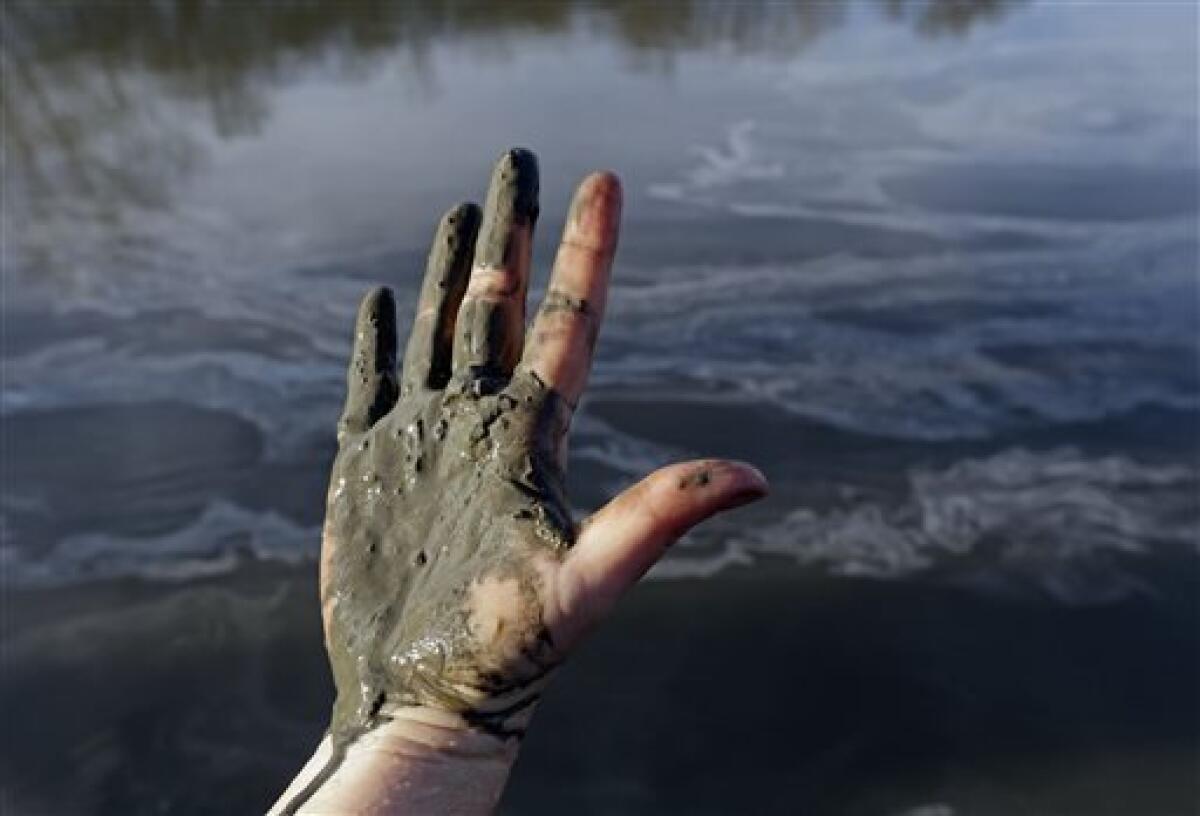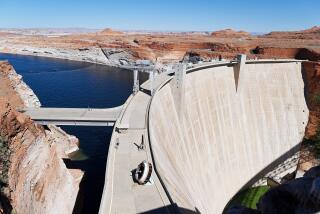Water safety threatened by North Carolina coal ash spill, group says

- Share via
EDEN, N.C. – An environmental group Thursday challenged Duke Energy’s assurances that drinking water from the Dan River in North Carolina and Virginia remained safe despite a massive spill of toxic coal ash that released a deluge of murky gray sludge into the river Sunday.
The Waterkeeper Alliance said its tests of water collected just yards from the spill site here showed dangerous level of toxins, including arsenic, chromium, lead, iron and other heavy metals. Arsenic levels in the samples were 35 times higher than the maximum containment level set by the Environmental Protection Agency for drinking water, the group said.
“The stuff flowing into the river out of that pipe is disturbingly high in toxins and laden with heavy metals,” Peter Harrison, staff attorney for the alliance, said as he stood on the riverbank downstream from the spill site late Thursday afternoon. Tests were conducted by a certified lab in North Carolina, he said.
The samples were collected Tuesday, 48 hours after the spill was discovered, Harrison said. He spent two hours in a kayak on the river Thursday, collecting more water samples whose test results are expected in a few days.
The Waterkeeper Alliance called the ash spill the third-largest in U.S. history. The biggest was a 2008 spill in Tennessee that unleashed more than a billion gallons of ash slurry, destroying homes, flooding residential areas and polluting waterways.
State regulators said initial test results, released Thursday night, found no violations of state water quality standards for 17 heavy metals in most samples taken Monday and Tuesday. Copper levels were above state surface water standards, the North Carolina Department of Environmental and Natural Resources reported.
Tom Reeder, director of the state Division of Water Resources, said tests of the water and river bottom sediments would continue. “The Dan River does not have a clean bill of health,” he said.
Duke Energy spokeswoman Paige Sheehan, standing on an overlook above the spill site at the company’s shuttered coal-fired Dan River plant, said company tests showed only traces of heavy metals within accepted safety standards for drinking water, fish and wildlife. Levels of arsenic, lead and selenium taken from water intakes at Danville, Va., and South Boston, Va., were less than two parts per billion – the lowest level that lab instruments can accurately measure, the company said.
Danville and South Boston are the nearest cities downstream from the spill, which Duke Energy said dumped between 50,000 and 80,000 tons of coal ash into the river after a 48-inch stormwater pipe ruptured beneath the ash basin. Some 24 million to 27 million tons of polluted water from the basin also poured into the Dan River, the company said.
The state of North Carolina, along with several environmental groups – including Waterkeeper Alliance – have sued Duke Energy over its handling of coal ash at the utility’s coal-fired plants. The Dan River plant, closed in 2012, is one of seven Duke decommissioned coal-fired plants. Another seven remain in operation.
Sheehan said crews were still working Thursday to plug the leak, four days after the spill was reported. She said they had managed to stop almost all water seepage from the basin and most of the flow from the ruptured pipe.
“It’s a very low flow and at times no flow,” Sheehan said, gesturing toward workers, trucks and a crane at the edge of the coal ash basin near the river’s edge.
Sheehan said the company has tested river water at 11 locations above and below the spill site, as well as near the spill itself. “There is no challenge to drinking water,” she said. “Drinking water is absolutely safe downstream.”
The Waterkeeper Alliance said levels of lead in its tests were far higher than levels recommended by the EPA to prevent contamination of drinking water. Dangerous levels were also detected for boron, manganese, zinc and iron, the group said.
“Duke could have avoided contaminating the Dan River and poisoning Virginia’s water supplies if it had removed its toxic ash heaps years ago after being warned by EPA,” said Robert F. Kennedy Jr., president of Waterkeeper Alliance.
Erin Culbert, a Duke spokesperson, said the highest arsenic level in samples taken from the river Monday was 35.3 parts per billion – below the state surface water standard of 50 ppb. The highest test results for samples filtered to indicate levels that would be expected after water is treated for drinking were 3.43 ppb, well below the 10 ppb drinking water standard, she said.
Duke is also having water tested at municipal water intakes downstream and after water has been treated by municipal water systems. “Results in both areas look very good,” Culbert said.
North Carolina Gov. Pat McCrory, a Republican and former Duke executive, visited the site Thursday and called the incident “a very serious spill,” adding, “We need to get it under control as quickly as possible.”
EPA officials began sampling water from the river Wednesday and sediment on the river bottom Thursday to determine the amount of ash that had settled there, said Dawn-Harris-Young, an EPA spokesperson in Atlanta.
Sheehan, the Duke spokeswoman, said hundreds of people were working at the spill site 24 hours a day, trying to come up with a way to plug the leak and to secure the pond.
Harrison, the Waterkeeper Alliance attorney, said water was still flowing from the ruptured pipe when he paddled near the site Thursday.
Culbert said at that site Thursday that efforts to deal with the spill could last for weeks.
ALSO:
Freaky ‘frost quakes’ boom and shake frozen Midwest towns
Junk mail misfire: Bank of America mailer calls woman ‘a slut’
Winds of change: Floating power turbines envisioned off Oregon coast
More to Read
Sign up for Essential California
The most important California stories and recommendations in your inbox every morning.
You may occasionally receive promotional content from the Los Angeles Times.











